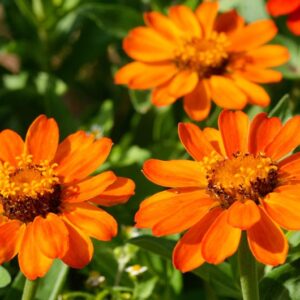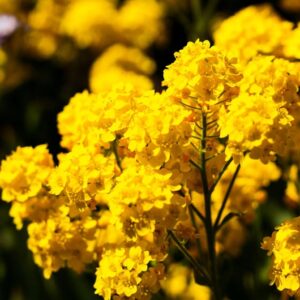
Delve into the world of floral enchantment as we unravel the rare and captivating flowers that start with Q. These remarkable blooms exude a unique charm, making them a fascinating subject for gardeners and flower enthusiasts. From delicate petals to vibrant colors, the flowers on this list offer a diverse range of shapes and sizes.
Join us on this floral journey as we discover the exceptional qualities of each of these exquisite flowers.
1. Queen Anne’s Lace

Image source: Pinterest
Queen Anne’s Lace, also known as Wild Carrot, is a delicate and lacy white flower with a small red or purple blossom at its center. It graces fields and meadows with its intricate beauty, resembling a delicate lace doily.
2. Quisqualis indica (Rangoon Creeper)

Image source: Pinterest
The Rangoon Creeper is a vigorous vine that produces clusters of fragrant, funnel-shaped flowers in shades of pink, red, and white. The blooms gradually change color as they age, creating a stunning display of multiple hues on a single vine.
3. Quisqualis fruticosa (Chinese Honeysuckle)

Image source: Pinterest
Chinese Honeysuckle, also known as Rangoon Creeper, is a tropical vine that showcases clusters of tubular flowers. The flowers start as white, gradually transition to pink, and eventually deepen into shades of red. This color-changing characteristic makes it an intriguing and visually dynamic addition to garden trellises or fences.
4. Quaking Grass

Image source: Pinterest
Quaking Grass, also known as Briza, is an ornamental grass that produces delicate, nodding flower heads. The flowers have a unique quality, swaying and “quaking” with the slightest breeze, adding a gentle, ethereal movement to garden landscapes.
5. Quamoclit coccinea (Cypress Vine)

Image source: Pinterest
Cypress Vine is a tender perennial vine with feathery, fern-like leaves and vibrant, star-shaped flowers. The flowers, which come in shades of red, pink, and white, attract hummingbirds and butterflies to the garden.
6. Quisqualis mollis (Cardinal Creeper)

Image source: Pinterest
Quisqualis mollis is a plant species commonly known as “Cardinal Creeper” or “Coral Vine.” It is a fast-growing tropical vine that belongs to the Combretaceae family. Quisqualis mollis is admired for its clusters of bright red, tubular flowers that appear throughout the growing season. T
7. Quamash (Camassia)

Image source: Pinterest
Quamash, also known as Camassia, is a bulbous plant that produces spikes of star-shaped flowers in shades of blue, lavender, or white. These charming blooms grace the garden with their beauty in late spring. Quamash is native to North America and is valued for its natural appeal, resilience, and ability to attract pollinators like bees and butterflies.
8. Quince

Image source: Pinterest
Quince is a fruit-bearing shrub or small tree that produces attractive blossoms in shades of white, pink, or red. These fragrant flowers emit a delightful scent that fills the air. While the flowers may be somewhat understated compared to other ornamental plants, they play an essential role in the Quince’s reproductive process, leading to the formation of the distinctively fragrant and flavorful Quince fruits.
9. Quamoclit lobata (Spanish Flag)

Image source: Pinterest
Quamoclit lobata, also known as Ipomoea lobata, and commonly referred to as Spanish flag or Firecracker Vine, is a flowering plant in the morning glory family (Convolvulaceae). This plant is native to Mexico and South America, but it is often grown in gardens around the world for its ornamental value. It gets its common name, “Spanish flag”, from the vivid, multicolored gradient of its blooms which bear a slight resemblance to the colors of Spain’s flag.
10. Quaker Ladies

Image source: Pinterest
Quaker Ladies is the common name for Houstonia caerulea, a charming perennial wildflower native to eastern North America. This plant is also commonly known as Azure Bluet or Innocence. The name “Quaker Ladies” reportedly comes from the flower’s resemblance to the plain bonnets worn by Quaker women in the past.
11. Quaking Aspen

Image source: Pinterest
Quaking Aspen, also known as Populus tremuloides, is a remarkable deciduous tree renowned for its vibrant fall foliage. Additionally, Quaking Aspen produces small greenish flowers that appear in catkins. These flowers are an important part of the tree’s reproductive process, leading to the formation of the tree’s small, rounded fruits with cottony seeds that disperse with the wind.
12. Quillaja saponaria (Soapbark Tree)

Image source: Pinterest
Quillaja saponaria is a large evergreen tree native to Chile. It is renowned for its inner bark, which contains high levels of natural saponins. The bark has been traditionally used for its soap-like properties, yielding a gentle lather when mixed with water. Quillaja saponaria also produces small, inconspicuous flowers that develop into clusters of small brownish fruits.
13. Quercus coccifera (Kermes Oak)

Image source: Pinterest
Kermes Oak is a shrub or small tree known for its leathery leaves and inconspicuous flowers. Its small acorns provide an important food source for wildlife, and its dense foliage offers shelter and nesting sites for birds and small mammals. The Kermes Oak is a resilient plant that thrives in dry and rocky habitats, making it a valuable species for landscape conservation.
14. Quassia amara (Quassia)

Image source: Pinterest
Quassia amara is a small tropical tree known for its medicinal properties. It produces clusters of small, inconspicuous flowers that give way to green capsules containing seeds. Quassia has a long history of use in traditional medicine, particularly in herbal preparations known for their bitter taste.
15. Quisqualis viscosa (Sticky Wombat Berry)

Image source: Pinterest
Sticky Wombat Berry, scientifically known as Quisqualis viscosa, is a tropical vine that displays clusters of fragrant, tubular flowers in shades of pink or white. Native to Australia, this vine attracts butterflies with its nectar-rich blooms. Its attractive foliage and ability to tolerate a range of soil types make it a popular choice for trellises or arbors in subtropical or tropical gardens.
16. Quinoa

Image source: Pinterest
Quinoa (Chenopodium quinoa) is a versatile and nutritious flowering plant that is primarily cultivated for its edible seeds. Native to the Andean region of South America, quinoa has gained worldwide popularity for its exceptional nutritional value and gluten-free nature. The plant produces clusters of small, inconspicuous flowers that can vary in color, including shades of white, yellow, pink, and purple.
17. Quamoclit pennata (Feathered Morning Glory)

Image source: Pinterest
Feathered Morning Glory, also known as Cypress Vine, is a fast-growing vine with delicate, feathery foliage and vibrant flowers. The tubular flowers come in shades of red or pink and attract hummingbirds and butterflies. The vine’s slender stems twine easily around supports, making it a popular choice for trellises, fences, or arbors.
18. Quercus robur (English Oak)

Image source: Pinterest
English Oak, scientifically known as Quercus robur, is a majestic tree that produces small greenish flowers known as catkins. These flowers play a crucial role in the oak’s reproductive process. English Oak is known for its strength, longevity, and stunning appearance. Its dense foliage provides shade and habitat for various wildlife species, making it a valuable tree for both ornamental and ecological purposes.
19. Quercus agrifolia (Coast Live Oak)

Image source: Pinterest
Coast Live Oak, scientifically known as Quercus agrifolia, is an evergreen tree native to the coastal regions of California and Baja California. It produces small greenish-yellow flowers in the form of catkins. These flowers play a vital role in the oak’s reproductive cycle, eventually leading to the development of acorns.
20. Quamoclit pedata (Crimson Glory Vine)

Image source: Pinterest
Crimson Glory Vine, scientifically known as Quamoclit pedata, is a climbing vine with feathery foliage and bright red, star-shaped flowers. These eye-catching blooms attract hummingbirds, adding an element of liveliness to the garden. Crimson Glory Vine is a heat-loving plant that thrives in full sun and well-drained soil, making it an excellent choice for creating vertical interest.
21. Quartz Pink

Image source: Pinterest
Quartz Pink is a hybrid variety of phlox that boasts fragrant, pink flowers. Its blooms add a splash of color to the garden and attract butterflies and bees with their nectar-rich rewards. Quartz Pink phlox is a popular choice for borders, rock gardens, or containers, providing not only visual appeal but also attracting pollinators to the garden.
22. Quiver Tree

Image source: Pinterest
Quiver Tree, scientifically known as Aloe dichotoma, is a unique tree species native to southern Africa. It is characterized by its distinctive, succulent-like trunk and branching structure. The tree produces clusters of tubular, yellowish-green flowers that attract pollinators such as birds and bees.
23. Quincy

Image source: Pinterest
Quincy, or Yucca x quincyensis, is a hybrid Yucca plant with impressive flower spikes that emerge from its rosette of spiky leaves. The flowers are creamy white and add architectural interest to the garden.
24. Quercus suber (Cork Oak)

Image source: Pinterest
Cork Oak is a medium-sized evergreen tree known for its thick, corky bark, which is harvested for a variety of purposes, including the production of cork. While the tree doesn’t produce showy flowers, it does produce small greenish-yellow catkins. These catkins contain the tree’s male and female flowers, playing a crucial role in the tree’s reproductive cycle.
25. Quamoclit carnea (Pink Morning Glory)

Image source: Pinterest
Pink Morning Glory is a climbing vine that delights with heart-shaped leaves and trumpet-shaped pink flowers that bloom in the morning. These enchanting flowers attract pollinators such as bees and butterflies to the garden. Pink Morning Glory is a vigorous grower, often blanketing fences, trellises, or walls with its lush foliage and showy blooms.
26. Quisqualis fructicans (Peruvian Lilac)

Image source: Pinterest
Peruvian Lilac, or Quisqualis fructicans, is a climbing vine that produces clusters of showy, fragrant flowers in shades of pink, purple, or white. The flowers, with their delightful scent, attract pollinators such as butterflies and bees. Peruvian Lilac adds a tropical touch to gardens, with its twining growth habit and the ability to cover structures such as pergolas or arbors with its attractive foliage and colorful blooms.
27. Quaking Star

Image source: Pinterest
Quaking Star, scientifically known as Dodecatheon meadia, is a charming perennial wildflower native to North America. It features clusters of nodding, bell-shaped flowers in shades of pink or purple. The unique characteristic of the flowers is their slender, reflexed petals that give the appearance of stars suspended on thin stems.
28. Quercus alba (White Oak)

Image source: Pinterest
White Oak is a large deciduous tree renowned for its sturdy nature and broad spreading canopy. While its flowers are inconspicuous and small, the tree’s main attraction lies in its attractive foliage, impressive stature, and iconic acorns. White Oak is a highly valuable timber tree and plays an essential ecological role by providing habitat and food for various wildlife species.


